The Wedding “Whirl and Vortex:” Mid-19th Century Wedding Preparations
by Ann Haddad
This is the third in a series of blog posts on mid-19th century courtship and wedding customs. Click for Part One, on 19th century Courtship, and Part Two, on Marriage Proposals and Engagements.
High Spirits at the Tredwells
Imagine the excitement in the family room of the Tredwell home on a spring evening in late March, 1845. Elizabeth, the eldest daughter of Seabury and Eliza Tredwell, had just named Wednesday, April 9, as the date of her wedding to Effingham Nichols. One can picture Elizabeth and her betrothed, perhaps along with her mother, Eliza, and her sister Mary, seated around the table in the family room, composing the guest list and writing out the wedding invitations. The wedding was only two weeks away, and so much needed to be done! The Tredwell family was about to leap head-on into what one contemporary etiquette manual referred to as “the whirl and vortex” of a wedding. This post will address three important aspects of mid-19th century wedding planning: invitations, the trousseau, and the duties of the groom.
The Transformation of the American Wedding
Elizabeth and Effingham were married in 1845, at a time when the form of the American wedding was gradually transitioning from a simple, family-centered, informal celebration to an elaborate, public, and expensive spectacle. We have no record of their wedding, so it is impossible to know the location, format, or style of their festivities. Seabury, however, given his wealth and social status, could afford to give his eldest and first-wed daughter an elaborate wedding with all the trimmings.
What Wedding Industry?
Up until the mid-19th century, the “wedding industry” (as the providers of services and goods for weddings are collectively known today), barely existed. Because a home wedding was the standard, and the bride’s family hosted the reception, gatherings were usually small and intimate. Many of the items in the bride’s trousseau were made by hand by family members, and the wedding dress was usually the work of a reputable dressmaker known to the family. New York City newspapers from the 1840s featured no advertisements for dedicated commercial wedding “vendors,” or professionals who furnish the trappings of an elaborate wedding. Whereas florists, jewelers, confectioners, and dry goods stores existed, very few items, save for wedding attire, were marketed with a specific eye to wedding celebrations.
This would all change in the late 1850s and especially after the Civil War, as the wedding industry became a huge commercial enterprise, and wedding rituals, especially among upper class families, became more formal, public, and elaborate. Businesses sprang up to cater to the needs of the bride-to-be, including stores that offered ready-to-wear bridal dresses and complete trousseaus. Women were faced with many more choices to consider in every aspect of their wedding, and therefore required more time to shop and plan. Moving the ceremony from the home to a church, along with, some years later, the option of holding the reception in a grand hotel, meant that many more guests could be accommodated; hence, guest lists grew accordingly.
Such Short Notice!
According to wedding etiquette manuals and contemporary diaries, in the first half of the nineteenth century wedding invitations were sent out anywhere from four days to two weeks prior to the wedding date. This short span of time between the date of the invitation and the actual wedding date reflects the simplicity of the wedding form and the minimal advance planning it necessitated.
For example, on Saturday, December 11, 1847, just eight days before her wedding to Andrew Lester, Mary Harris wrote in her diary: “… we were very much engaged in preparing the invitations to be sent next Monday if nothing happens.”
In a letter dated November 1, 1854, from Phebe Tredwell to her sisters (who were at the family summer home in Rumson, New Jersey), she stated: “Shortly after you left on Saturday we received an invitation to Caroline Quackenbush’s wedding next Wednesday from 1 to 3.”
And on November 24, 1855, one month before his marriage to Agnes Suffern, Edward Tailer wrote in his diary: “It will soon be time for us to spend several evenings in directing the invitations.”
The Tredwell/Nichols Guest List
We know neither the size of the guest list for Elizabeth and Effingham’s wedding, nor the names of those invited. Both the Tredwell and Nichols families were wealthy and prominent members of elite New York society. Both had large extended families; Seabury had many former business associates; Effingham had colleagues; and undoubtedly both families had a large circle of friends. So chances are the guest list was long, especially since the Tredwells could accommodate a large gathering in their Greek Revival double parlors, and guests were accustomed to having to cram into the indoor spaces for the festivities.
The Etiquette of Courtship and Matrimony (1852) warns, however, that any friends denied an invitation to the reception, because of lack of sufficient space, should not feel affronted. Rather, “It is considered a matter of friendly attention to those who cannot be invited, to be present at the ceremony in the church.”
A Sociable, or a Wedding?
Wedding invitations were hand written, in the same style as an invitation to a sociable (the 19th century term for a social gathering). The invitation usually did not announce that a wedding was to be celebrated. This speaks to the rather informal approach taken to the wedding itself, and the fact that most weddings were held in the home of the bride’s parents. So how did guests know to expect nuptials? For one thing, relatives and friends knew of the couple’s engagement, which had gone on for several months at the very least. And once the date had been set by the bride-to-be, both hers and the groom’s families shared the details within their circles by word-of-mouth. In that sense, the written invitation was a formality. In an article on New York fashion in the Buffalo Daily Courier from 1849, a gentleman commented on the speed with which news of a wedding date got around: “It is known in an hour from Union Square to the Battery.”
| .. |
In an 1844 article in the New York Daily Herald, one observant young friend of a future bride detected something in the air:
“For several days previous, the bright and happy faces of the fair ones told me that the gala night was nigh at hand. At length all doubt was removed, when a note of invitation was left at my address, stating that Miss B— would be at home on Wednesday evening, January 3rd; and then I knew that the bridal of one of our fairest maidens was to take place.”
Etiquette dictated that the wedding invitation include only the name of the bride’s parents, the date and the time. In the invitation pictured at left, written on April 15, 1854, for an April 25 wedding, no mention of a wedding is made:
“Mr. And Mrs. D.R. Floyd-Jones request the pleasure of Mr. and Mrs. L.W. Jones’ company on Tuesday evening, 25th just at 8 1/2 o’clock.
April 15th
Fort-Neck”
As the bride was married at her parents’ home, mentioning that a wedding was to take place was deemed unnecessary. Note the evening hour, 8:30 p.m., which was typical for a home wedding.
A church wedding, on the other hand, usually took place in the morning. According to The Ladies’ Book of Etiquette and Manual of Politeness (1860):
“In this case [weddings at church], none are invited to the ceremony excepting the family …”
Additional guests were invited to the reception, held at the bride’s parents’ home following the church ceremony. If Elizabeth and Effingham were married at church, their wedding invitation may have read as follows:
“Mr. and Mrs. Seabury Tredwell
request the pleasure of Mr. and Mrs. Jones’ company,
on Wednesday morning next, at eleven o’clock,
361 Fourth Street [the house number in 1845]
Thursday, April 2nd”
All Those Penmanship Drills Pay Off
In the 1840s, wedding invitations were hand written in a fancy cursive script on white card stock. This was hardly a challenge for well-educated young ladies; excellent penmanship was considered an essential requirement for completion of finishing school. Engraved and printed invitations did not become popular until the early 1860s; ten years later, in keeping with the formality and grandeur of the wedding itself, and more practical given the longer guest lists, such mass produced invitations became de rigueur. Note the engraved invitation (pictured at right) to the 1865 wedding of the daughter of Mrs. J. Kearny Rodgers at Trinity Chapel. Despite the formality of the style, the bride-to-be’s name is not mentioned. One assumes that Mrs. Rodgers had only one daughter!
The Bridal Trousseau
The custom of a bridal trousseau, i.e. the clothing and “soft goods” (such as bed and table linens) that a bride brought to her marriage, became increasingly popular in the mid-19th century. The size of a trousseau depended on the family’s wealth and the position the couple would be assuming in society. For Elizabeth, as the wife of a well-to-do attorney who no doubt had many social obligations, a proper trousseau consisted of a lady’s complete wardrobe (including the wedding gown) sufficient for at least an entire year. This elaborate trousseau assemblage undoubtedly occupied most of Elizabeth’s time prior to her wedding.
According to The Ladies’ Book of Etiquette, Fashion, and Manual of Politeness:
“In preparing a bridal outfit, it is best to furnish the wardrobe for at least two years, in under-clothes, and one year in dresses, though the bonnet and cloak, suitable for the coming season, are all that is necessary, as the fashions in these articles change so rapidly.”
Shop ’Til You Drop
Elizabeth no doubt received a sum of money from her father with which to purchase her trousseau. It is impossible to know the cost of a trousseau in 1845, as it varied depending on the family’s social status and financial resources. In 1850, Godey’s Lady’s Book estimated that the cost of the wedding dress and veil alone to be $650. Add to that all the other complements of the trousseau, and one may safely assume that the amount spent on a trousseau by a wealthy family like the Tredwells would be upwards of $1,000 (approximately $30,000 today).
Upon the announcement of her engagement, Elizabeth, assisted by her mother, sisters, and close friends, likely commenced sewing many of the personal items included in the trousseau, such as petticoats, corset covers, nightgowns, dress sleeves, and handkerchiefs. Once her wedding date was set, the shopping began with a vengeance at popular dry-goods stores, such as A.T. Stewart, then located on Broadway near Chambers Street, and Lord and Taylor, then located on Catherine Street. These emporiums stocked many trousseau items in addition to dresses, such as sewing implements, linens, shawls, slippers, and hair combs and brushes.
In the short story Incompatibility of Temper, by Alice B. Haven, published in the January 1862 issue of Godey’s Lady’s Book, the author describes how the bride’s trousseau has taken over one bedroom:
“The best bedroom was draped with the new dresses that had been made up with much thought and consultation of the fashion magazines; the clothes-press was entirely occupied by the wedding dress itself, over which a sheet was carefully hung to protect it from all possible contact with dust or flies; and Marie’s own drawers were overflowing with the four dozen cotton and two dozen linen, to say nothing of nightcaps, which were at least happily completed. There were twenty things to be done yet …”
The Most Important Item of a Trousseau: the Wedding Dress
According to the August 1849 issue of Godey’s Lady’s Book, the “etiquette of trousseau” dictated that a fashionable wedding dress be made of white silk or satin, with a Brussels lace over-dress with a fitted bodice and full skirt. A white veil, long and full, and most likely made of Brussels lace, was attached to an artificial wreath of orange blooms (popularized by Queen Victoria, who wore them at her wedding in 1840) that encircled the head. Flat white satin or silk slippers decorated with ribbons; white silk stockings; short white kid gloves; and an embroidered handkerchief (perhaps with interlaced initials of the bride and groom), completed the ensemble.
According to etiquette manuals such as The Lady’s Guide to Perfect Gentility (1846), jewelry was practically forbidden: “She should wear no ornaments but what her intended or father should present her for the occasion.”
In a letter sent by a “Sarah” from Manhasset, Long Island to Ida A. Coles, dated April 18, 1847, she wrote:
“She [the bride] has ten new dresses and some of them are very handsome. The wedding dress is white satin with an embroidered lace over, it is beautiful. She has not purchased her veil as yet.”
Dressmaker Required
Eliza Tredwell most likely hired a dressmaker to create Elizabeth’s wedding ensemble. The seamstress may have lived with the family for a few weeks before the wedding, sewing the dresses in return for room and board, or for a set fee. Imagine the excitement with which Elizabeth and her mother examined the latest silk and satin fabrics, imported from France and widely available at the many dry-good stores that catered to ladies’ fashions, such as H. Myers & Gedney, located at 375 Broadway.
Elizabeth’s fine white bridal slippers may have come from J.B. Miller’s shoe store, located at 142 Canal Street, which in 1844 advertised “White and Black satin, also french, Morocco and Kid slippers, for Balls, Parties, Weddings, &c.”
Ready-to-wear bridal dresses were not widely available in stores until the 1860s, but the earliest advertisements for “wedding dresses,” as distinct from dresses for other occasions, and made in France, appeared in New York newspapers by the mid-1840s. One enterprising woman was selling them in 1844, according to an advertisement in the New York Daily Herald:
“Madame N. Scheltema informs her customers … that she has just received per last Havre packet, a new and splendid assortment of rich embroidered and other Wedding Dresses.”
James Beck & Co., and William A. Smets, two dry-goods stores located on Broadway, advertised “Wedding and Soiree Dresses.” Shops like these, however, no doubt catered to the wealthy upper class, who could afford the fine items sold there. The Tredwell family probably patronized these establishments.
Dressing the Rest of the Family
One can only imagine Eliza’s state of mind in the weeks before her daughter’s wedding. Not only did she have to oversee Elizabeth’s trousseau and all it entailed, she was also faced with the daunting task of dressing herself and her FIVE other daughters! There were new ensembles to be purchased (white dresses for those sisters chosen to be bridesmaids); and a hairdresser to be engaged for Eliza, Elizabeth, and perhaps Elizabeth’s sister Mary (who at 20 was considered a young lady). Her wealth would have allowed Eliza to hire a dresser to assist the women with their toilettes.
Eliza also bore the responsibility of making sure that Elizabeth’s younger brothers Horace and Samuel (ages 21 and 18, respectively), were properly attired. Whether or not they were groomsmen, because of their age their outfits would have been very similar to Effingham’s (described below).
Mrs. Abiel Abbot Low, a wealthy woman who lived in Brooklyn Heights, recorded in her diary the extensive preparations for the wedding of a family member, to be held on Sunday, February 2, 1845 (just two months before Elizabeth’s wedding). She made frequent trips by coach back and forth from her home in Brooklyn to Manhattan for this purpose. On Thursday January 23, 1845, she wrote: “I selected a superb silk dress at Stewart’s to wear to Josiah’s wedding.”
Several days later, on Thursday January 30, she noted: “I went to New York to engage Martelle to dress my hair for the wedding, but he was engaged for the time that I needed him. I bought a pretty evening fan …”
What Does Effingham Do?
Compared to Elizabeth’s multiple wedding chores, Effingham had relatively little to do. As his father, the Reverend Samuel Nichols, was to perform the wedding ceremony, it spared him the headache of having to track down an available rector, as Henry Patterson indicated in his diary on July 14, 1844, one week before his wedding:
“I made an engagement with Mr. Edwin Hatfield pastor of the Presbyterian Church, corner of Broome and Ridge Street, to perform the marriage ceremony for us, next Thursday evening at eight o’clock. I endeavored to get Mr. Bellows or Mr. Dewey, but they are both absent from the city.”
Custom dictated that the groom was also responsible for finding a suitable home for his bride. Effingham was spared this task, however; after the wedding and travel (if any) he simply joined his bride at the Tredwell home on Fourth Street. It was not atypical for newlyweds to live with family, which gave a man time to establish himself in business before buying a home.
If a “wedding tour” (as it is called in The Art of Good Behavior) was planned for after the marriage, Effingham made the arrangements, including clearing his work schedule for anywhere from two weeks to one month to accommodate his absence.
Effingham Gets Dressed Up, Too
Men’s fashion in the 1840s was characterized by low, tightly cinched waists; snug waistcoats and trousers; high collared shirts tied with a cravat; and flared frock-coats. The groom’s attire is described in The Art of Good Behavior:
“The bridegroom must be in full dress, black or blue dress coat, which may be faced with white satin; a white vest, black pantaloons, and dress boots, or pumps, with black silk stockings, and white kid gloves, and a white cravat. The groomsmen should be dressed in a similar manner.”
In the 1840s, a colorful, embroidered waistcoat was a fashionable item in a groom’s attire. The waistcoat was occasionally worked by the bride, and presented as a wedding gift to the groom. Elizabeth may have shopped at William T. Jennings on Broadway, which advertised in 1844, “a lot of rich silk and satin vestings, suitable for ball and wedding vests,” for material for Effingham’s waistcoat.
Destroy the Evidence!
The Etiquette of Courtship and Matrimony also strongly recommended that a gentleman begin his marriage with a clean moral slate, by divesting himself of certain bachelor friends whose company would not be deemed fitting for a newly married gentleman. Burning one’s bachelor letters is also considered essential, for: “Not to do this might hereafter lead to inconvenience.”
Not a Whisker Out of Place
One other concern may have occupied Effingham’s mind before the wedding. If he sported whiskers, they must be neat and full by his wedding day. So, he may have followed the lead of Henry Patterson, who on Sunday, May 19, 1844, approximately two months before his wedding, wrote in his diary: “I cut off my whiskers, intending immediately to let them grow again, so as to have a new sett [sic] on my wedding day.”
With This Ring I Thee Wed
The task that probably had the greatest significance for Effingham was purchasing Elizabeth’s wedding ring. The fashion for wedding bands was plain, thick gold. Although jewelry store advertisements were plentiful in newspapers in 1845, only one, William Wise, located at 79 Fulton Street in Brooklyn, offered “gold wedding rings” for sale. To ensure that the ring was properly sized for his bride, according to the Etiquette of Courtship and Matrimony, the man must: “… get a sister of your fair one to lend you one of the lady’s rings.” One can just picture Effingham convincing Mary to secretly remove a ring from Elizabeth’s jewelry box!
In the poem “The Bridal” (1849), which one may imagine had been written with Elizabeth and her sisters in mind, one finds reference to the wedding ring:
“Oh! They are blest indeed, and swift the hours
Till her young sisters wreathe her hair in flowers.
Then before all they stand; the holy vow,
And ring of gold—no fond illusion now—
Bind her as his.”
Stay tuned: the next blog post will cover the wedding day!
|
Sources:
- Anonymous. The Art of Good Behavior, and Letter Writer, on Love, Courtship, and Marriage: A Complete Guide. New York: Huestis & Cozans, 1845. Main Collection, New-York Historical Society.
- Anonymous. The Etiquette of Courtship and Matrimony. London: David Bogue, 1852. books.google.com. Accessed 1/18/18.
- Bradford, Isabella. “A Fashion Worth Revisiting? A Bridegroom’s Embroidered Wedding Waistcoat, 1842.” Two Nerdy History Girls. Tuesday, November 11, 2014. www.twonerdyhistorygirls.blogspot.com. Accessed 4/4/18.
- The Brooklyn Daily Eagle. Wednesday, March 5, 1845, p. 3. www.newspapers.com. Accessed 4/6/18.
- Coles Family Papers, 1803-1859. Manuscripts Division, New-York Historical Society.
- David R. and Mary Floyd-Jones Invitation, 1854 April 15, Floyd-Jones Papers. Manuscripts Division, New-York Historical Society.
- Emily Hosack Rodgers Collection, 1848-1888. Manuscripts Division, New-York Historical Society.
- “Etiquette of Trousseau.” Godey’s Lady’s Book. August, 1849.
- The Evening Post. Tuesday, 16 January, 1844, p. 3. www.nespapers.com. Accessed 3/6/18.
- The Evening Post. Friday, 26 January, 1844, p. 4. www.newspapers.com. Accessed 3/13/18.
- The Evening Post. Friday, 6 September, 1844, p. 1. www.newspapers.com. Accessed 3/6/18.
- The Evening Post. Saturday, November 16, 1844, p. 2. www.newspapers.com. Accessed 3/21/18.
- The Evening Post, Monday, 10 March, 1845, p. 2. www.newspapers.com. Accessed 3/30/18.
- Hartley, Florence. The Ladies’ Book of Etiquette, Fashion, & Manual of Politeness. Boston: G.W. Cottrell, 1860. www.gutenberg.org. Accessed 3/15/18.
- Haven, Alice B. “Incompatibility of Temper.” Godey’s Lady’s Book. January, 1862.
- Lester, Mary H. Diary, 1847-1849. Manuscripts Division, New-York Historical Society.
- Low, Harriet. Diary, 1844-45, Low Family Papers, 1750-1900. Manuscripts Division, New-York Historical Society.
- New York Daily Herald. Tuesday, 27 February, 1844, p. 1. www.newspapers.com. Accessed 3/13/18.
- New York Daily Herald. Saturday, May 18, 1844, p. 3. www.newspapers.com. Accessed 3/11/18.
- New York Daily Herald. Thursday, April 24, 1845, p. 1. www.newspapers.com. Accessed 3/16/18.
- “New York Fashions.” Buffalo Daily Courier. Monday, 5 November, 1849, p. 3. www.newspapers.com. Accessed 3/18/18.
- New York Tribune. Saturday, 28 December, 1844, p. 3. www.newspapers.com. Accessed 3/7/18.
- O’Neil, Patrick W. Tying the Knots: The Nationalization of Wedding Rituals in Antebellum America. Dissertation Thesis, University of North Carolina, Chapel Hill, 2009. www.cdr.lib.unc.edu. Accessed 3/15/18.
- Patterson, Henry. Diaries, 1832-1848. Manuscripts Division, New-York Historical Society.
- Pinckney, Cotesworth, ed. The Wedding Gift, To All Who are Entering the Marriage State. Lowell: Milton Bonney, 1849. www.babel.hathitrust.org. Accessed 4/5/18.
- Reeves, Emma. History of the Bridal Trousseau. September 15, 2016. www.theribboninmyjournal.com. Accessed 3/18/18.
- Rothman, Ellen K. Hands and Hearts: A History of Courtship in America. Cambridge: Harvard University Press, 1987.
- Tailer, Edward Neufville. Diaries, 1848-1917. Manuscripts Division, New York-Historical Society.
- Thornwell, Emily. The Lady’s Guide to Perfect Gentility: In Manners, Dress, and Conversation. New York: Derby & Jackson, 1856. www.archive.org. Accessed 1/17/18.
- Tredwell, Phebe. Letter, November 1, 1854. Nichols Family Papers. Manuscripts Division, New-York Historical Society.
- Victoria and Albert Museum. “History of Fashion 1840-1900.” www.vam.ac.uk. Accessed 4/4/18.
- Wallace, Carol McD. All Dressed in White: The Irresistible Rise of The American Wedding. New York: Penguin Books, 2004.
- “Wedding Memories: The Bride’s Trousseau.” Magpie Wedding. www.magpiewedding.com. Accessed 4/9/18.
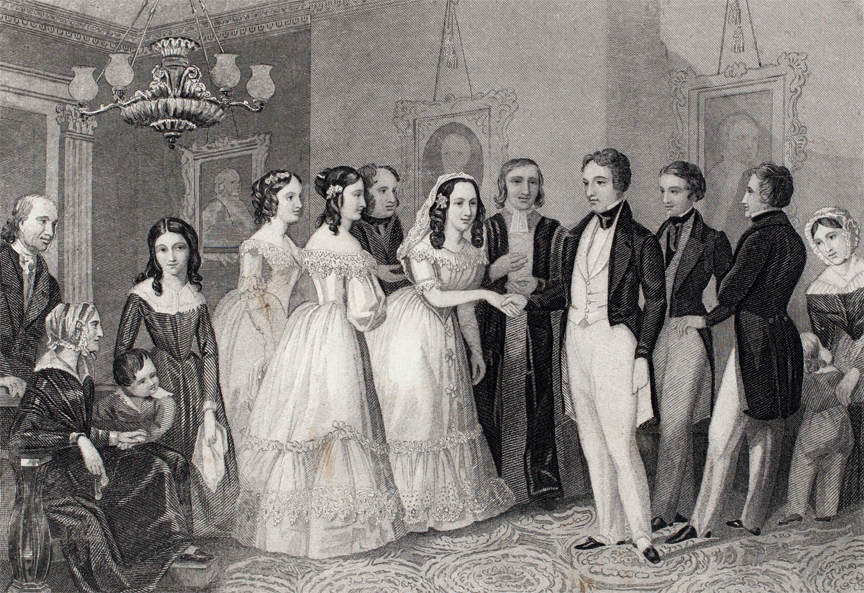

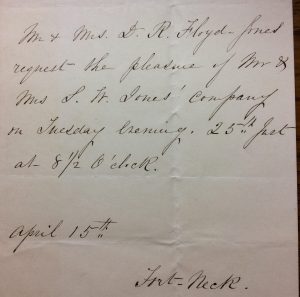
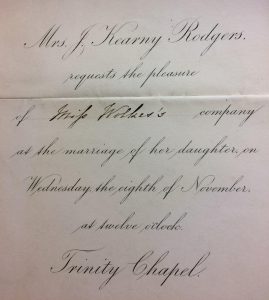
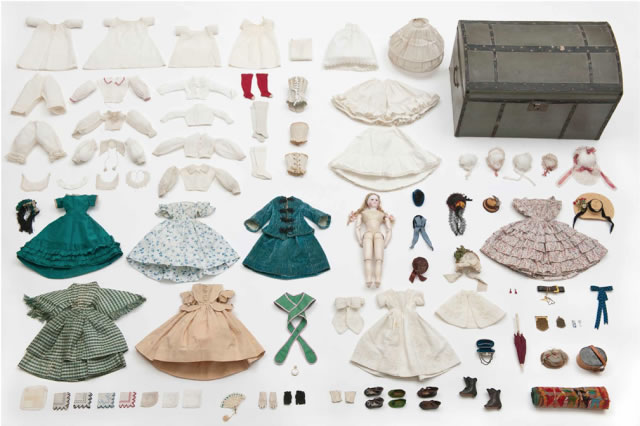
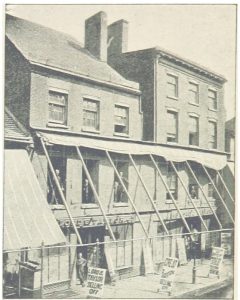
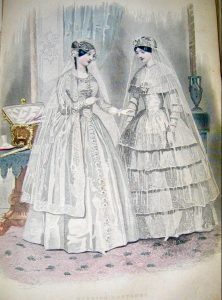
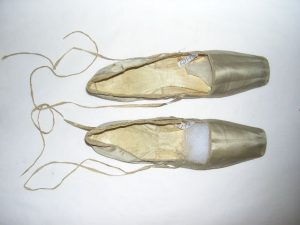

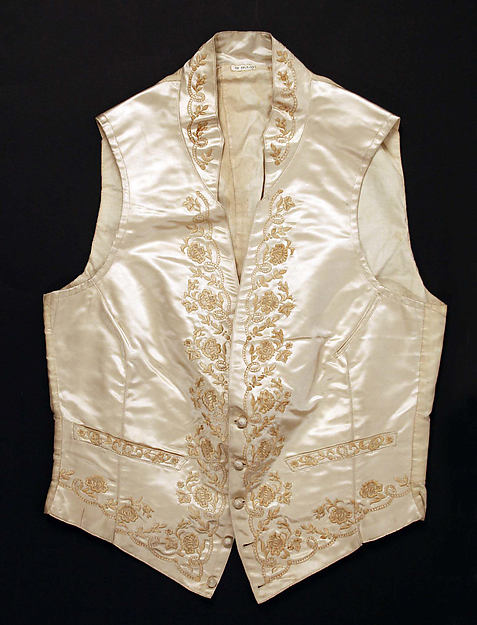



Hi, I’m interested in the John Forrest “wedding” picture… I’m not having any luck online.. where did you find that image?
Hi Pamela,
The engraving of “The Wedding” can be found in the collection of the American Antiquarian Society. It’s also available on Wikipedia Commons — you might have better luck searching for John B. Forrest or J.B. Forrest.
Many surprises in this blog. Particularly interesting to me was the contrast between the cost of the wedding dress and the simplicity and downright casualness of the ceremony; all that money for a dress few would see. Was it considered okay for a bride to wear her dress for subsequent occasions?
Overall, I admire the way Annie scrupulously tells us what she doesn’t know and then interestingly fills in the blanks with well-documented inferences. Great work!
Hi Liz,
Research tells us that the bride traditionally wore her bridal ensemble when she and her husband received callers (their first as man and wife), in the first few weeks after the nuptials. Typically, the day and time they would be receiving was conveyed in a fun way, but you’ll have to wait for the next installment to learn what that was!
Also, for the reason you mention, a bride would often have her dressmaker make another bodice that could replace the original, thereby making the dress useful for other social occasions.
Thanks so much for your inciteful comments, Liz!
Annie
This is a wonderful, informative post, based on the exhaustive research we have come to expect from you! Shows how important it is to understand the historical context of the Tredwells’ lives. Like Liz I am surprised at the extensive preparation and amount of money spent on the trousseau and the casual offhand way the actual wedding came off. Today it seems there is less emphasis on accumulating the trousseau (and surely nobody is embroidering their underwear in anticipation of the event) and an extreme emphasis on the theatricality of the actual ceremony.
Thank you, Mary! I can’t expain the trousseau expense, but I suspect that the short notice had to do with the home wedding limitations, as well as one very important aspects of Antebellum life: the preponderance of death, which cautioned against too much advance planning. In all of the diaries I read for this series, a death, often of a young person, is mentioned every three or four pages. Note Mary Lester’s diary entry of December 11, 1847, mentioned above: “We were very much engaged in preparing the invitations to be sent next Monday, if nothing happens.”